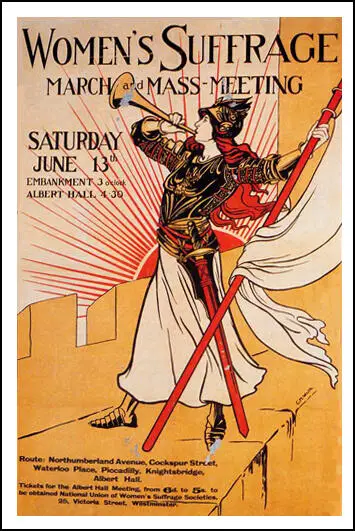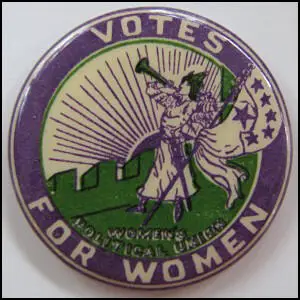Caroline Watts
Caroline Watts, the youngest of the six children of Robert Watts, a button manufacturer, and his wife Mary Watts, was born in 1868. Her mother died two years later. Watts was a successful businessman and by 1871 he was employed 470 employees. (1)
In 1886 she began studying art at the Slade School. Watts continued her studies until 1892. She provided illustrations for a variety of newspapers and magazines including the Pall Mall Gazette. In 1894 her father died and left her £8,000 and she set up home with her sister Mary. (2)
In around 1899 she began illustrating a series of translations of Arhurian and other romances. These were published by the firm of David Nutt run by Alfred Trubner Nutt. After his death his French wife, Marie Nutt, took over the running of the firm. Marie was a member of the National Union of Suffrage Societies (NUWSS) and over the next few years she published several books and pamphlets advocating women's suffrage. (3)
Watts became a member of the NUWSS and the Artists' Suffrage League (ASL). In 1908 Watts produced The Bugler Girl to advertise the important June 1908 NUWSS procession. Elizabeth Crawford has pointed out: "The central figure in this, the 'Bugler Girl', is closely associated with the heroic images Caroline was creating for the books commissioned by David Nutt and in 1908 struck a suitably chivalric note." (4) Lisa Tickner explained why it became such an important posters: "A woman trumpeter, standing on ramparts, flag in hand, and blowing an inspiring call to the women of Great Britain to come out and stand by their sisters in this fight." (5)

The image created by Watts appeared on NUWSS posters and pamphlets. It was also used on a badge given to NUWSS's paid organisers. However, by 1913, with Women's Social and Political Union (WSPU), militancy intensified, the NUWSS pointed out that it did not mean that it was a violent organisation. A member of the NUWSS governing-council argued in The Common Cause: "Our Bugler Girl carries her bugle and her banner; her sword is sheathed by her side; it is there, but not drawn, and if it were drawn, it would not be the sword of the flesh, but of the spirit. For ours is not a warfare against men, but against evil." (6)

Harriet Stanton Blatch the daughter of Elizabeth Cady Stanton was a member of Congressional Union for Women Suffrage (CUWS) that had been formed by Alice Paul and Lucy Burns. The organisation attempted to introduce the militant methods used by the WSPU in Britain. This included organizing huge demonstrations and the daily picketing of the White House. Ken Florey has argued that the CUWS made use of Watts's image: "It employs the purple, green, and white colors of Emmeline Pankhurst's English organization, the Women's Social and Political Union, and adapts the "Bugler Girl" design created by Caroline Watts for the National Union of Women Suffrage Societies. The button's colorful nature and its militant figure reflect the more activist approach to suffrage on the part of the WPU as opposed to that of its more conservative counterpart, the National American Woman Suffrage Association." (7)
Caroline Watts died in Dorset in 1919.
Primary Sources
(1) Elizabeth Crawford, Art and Suffrage: A Biographical Dictionary of Suffrage Artists (2018)
It is not known when exactly Caroline Watts became involved with the Artists Suffrage League but she was the designer, on behalf of the ASL, of the image used to advertise the important June 1908 NUWSS procession. The central figure in this, the 'Bugler Girl', is closely associated with the heroic images Caroline was creating for the books commissioned by David Nutt and in 1908 struck a suitably chivalric note. By 1913v, however, as WSPU militancy intensified, the NUWSS was at pains to make clear that the militaristic imagery of the 'Bugler Girl' did not mean that it was a violent organisation.
(2) The Common Cause (14th November, 1913)
Our Bugler Girl carries her bugle and her banner; her sword is sheathed by her side; it is there, but not drawn, and if it were drawn, it would not be the sword of the flesh, but of the spirit. For ours is not a warfare against men, but against evil.
(3) Elizabeth Crawford, Caroline Watts and the Bugler Girl (3rd December, 2014)
In his most useful and interesting book – Women's Suffrage Memorabilia – Ken Florey reveals that Harriot Stanton Blatch, daughter of Elizabeth Stanton and a long-time resident in England, poached Caroline Watts' ‘Bugler Girl' design for use by the Women's Political Union, the WSPU-inspired society she had founded on her return to the USA. Significantly the design was recoloured in purple, white and green (colours of course, borrowed from the WSPU) and became a well-known icon of the US women's suffrage movement.
(4) Ken Florey, Suffrage Buttons (5th October, 2012)
The Clarion button pictured here was the product of the Women's Political Union, formed by Harriot Stanton Blatch, daughter of Elizabeth Cady Stanton. It employs the purple, green, and white colors of Emmeline Pankhurst's English organization, the Women's Social and Political Union, and adapts the "Bugler Girl" design created by Caroline Watts for the National Union of Women Suffrage Societies. The button's colorful nature and its militant figure reflect the more activist approach to suffrage on the part of the WPU as opposed to that of its more conservative counterpart, the National American Woman Suffrage Association.

